
2015.2 | 2015.1 | 2014.2 | 2014.1
2013.2 | 2013.1 | 2012.2 | 2012.1 | 2011.2 | 2011.1 | 2010.2 | 2010.1
2009.2 | 2009.1 | 2008.2 | 2008.1 | 2007.2 | 2007.1 | 2006
August – December 2006
- December 2006 Newsletter – Dec 2
- October 2006 Newsletter – Oct 2
- Other August News – Aug 7 & 16
- August 2006 Newsletter – Aug 2
December 2006 Newsletter
Shows and Exhibitions
Pala International News
Mineral News
Shows and Exhibitions
Tucson Time – January 31–February 11, 2007
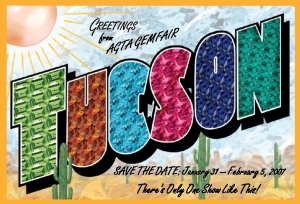 |
Following the holidays, make your plans for the world’s greatest gem and mineral show in February. Pala International will be represented, as follows.
Event: AGTA GemFair
When: January 31–February 5 , 2007
Where: Tucson Convention Center
Booth: 1016–1018
Event: Westward Look Mineral Show
When: February 2–6, 2007
Where: Westward Look Resort
Suite: 236
Website: Official show website
Event: 52nd Annual Tucson Gem and Mineral Show
When: February 8–11, 2007
Where: Tucson Convention Center
Booth: Aisle 5 East
We look forward to seeing our many friends there. Visit the Pala International Show Schedule for future events. [back to top]
Denver Show Pix
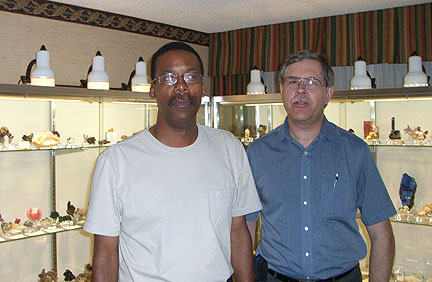 |
| Mike Wise (above left) a Geologist at the Smithsonian National Museum of Natural History, with Jeff Post, the museum’s Curator-in-Charge. Below, Pala International’s John McLean with Palagems.com webmaster David Hughes, in the Pala sales room at the 2006 Colorado Mineral & Fossil Show. |
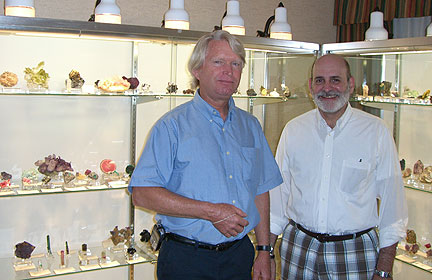 |
[back to top]
Houston Museum’s Cullen Hall Dazzles
New Gem Vault Opens
As we reported in our Gem News two weeks ago, Pala’s own Gabrièl Mattice attended the opening of the Lester and Sue Smith Gem Vault, the newest permanent exhibition at the Houston Museum of Natural Science. For the past three years, Gabrièl has consulted as an advisor in the procurement of the new collection.
While she was there, Gabe took her usual stroll through the Cullen Hall of Gems and Minerals, which houses the Gem Vault. The following snapshots are a few of the personal favorites she wanted to share with us. While simply taken with her digital camera, they clearly demonstrate the caliber of the specimens, described by the museum as “the world’s finest display-quality collection of gems and minerals.”
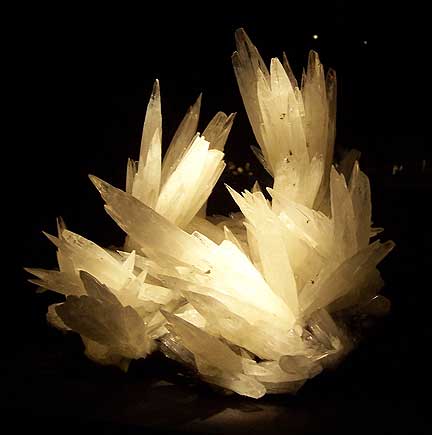 |
| Calcite cluster with jagged intertwined crystals pointing in every direction. |
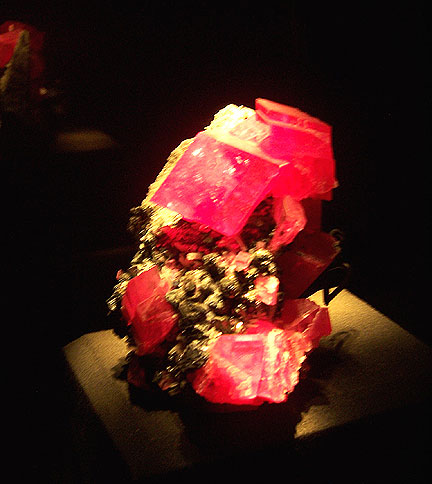 |
| Rhodochrocite specimen with large cubic crystals on a matrix of tetrahedrite and quartz. |
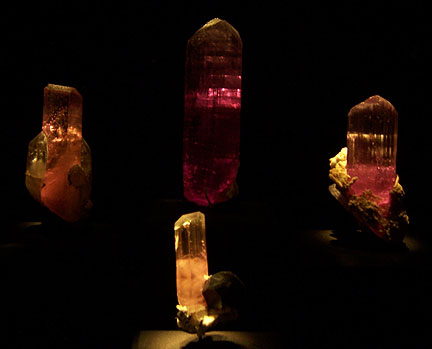 |
| Spodumene group showing the variation of colors, from the pink hue of kunzite to some more unusual color combinations. |
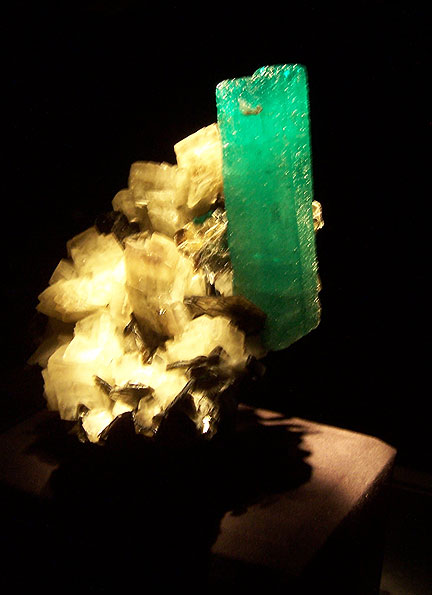 |
| Emerald crystal with calcite and mica from North Carolina weighs in at a record-setting 1,869 carats. |
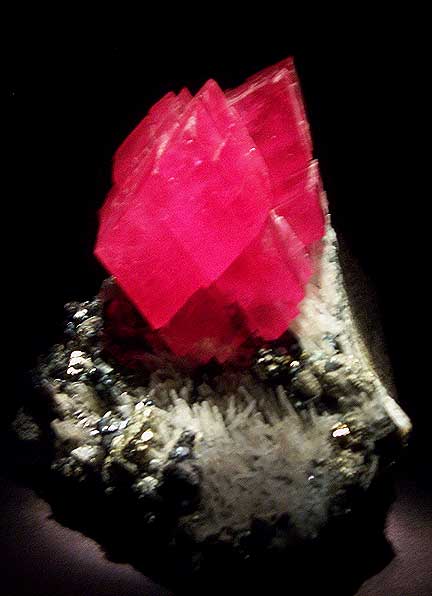 |
| Rhodochrocite—another striking example of nature’s ability to produce such a pure color. |
[back to top]
Pala International News
Pala’s Featured Mineral Specimens: Zoisite
In this edition of Mineral News we feature natural yellow zoisite from the Merelani Hills of Tanzania.
The first is a well formed crystal with an excellent multi-faced termination. The overall shape of the crystal follows suit for tanzanite, yet the color is quite unusual for zoisite, with hints of of green and gold shining through different axes. A great specimen to complement any tanzanite collection showing the unusual colors of zoisite. Price: $4,200.00.
 |
| Yellow zoisite, Merelani, Tanzania, weight 79.48 ct, dimensions 2.8 x 2.3 x 1.3 cm. This specimen has been sold. (Photo: Wimon Manorotkul) |
Our second featured item is a rough & cut yellow zoisite pair. This interesting pair shows another side of zoisite. The rough piece has a nice euhedral shape, excellent termination, and the upper third of the crystal is very gemmy, making it a superb specimen. The faceted gem is a pleasing cushion shape showing blends of yellow and green. The couple is well priced for $6,400.
[back to top]
Mineral News
Record Aquamarine Specimen
A serendipitous find in the Colorado high country brings a lone collector down the mountain with a North American record. Steve Brancato found this colossal aquamarine specimen near the summit of Mt. Antero in the Sawatch range of Colorado.
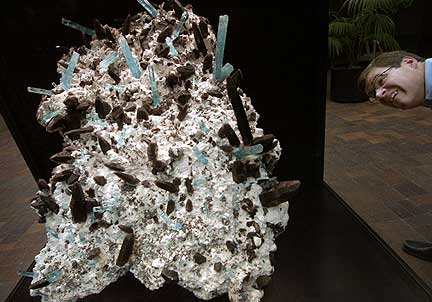 |
| Aquamarine specimen. This colossal cluster has now found a home at the Denver Museum of Nature & Science. (Photo: Craig F. Walker, Denver Post) |
Brancato was excavating a pocket when “out rolls a little 25-carat gemmy, a really nice blue aquamarine. I knew I was into something else, obviously,” he recalled to the Denver Post, later naming the find “Diane’s Pocket” in tribute to his mother. Brancato extracted the cluster piecemeal over the next three days. After two weeks of hauling 1,000 pounds of material down the mountain, the specimen was eventually reconstructed, from fragments, to its full stature, now measuring 37 by 25 inches and weighing 100 pounds. The cluster contains white feldspar, silvery mica, red garnets, black quartz, and over 100 aquamarine crystals.
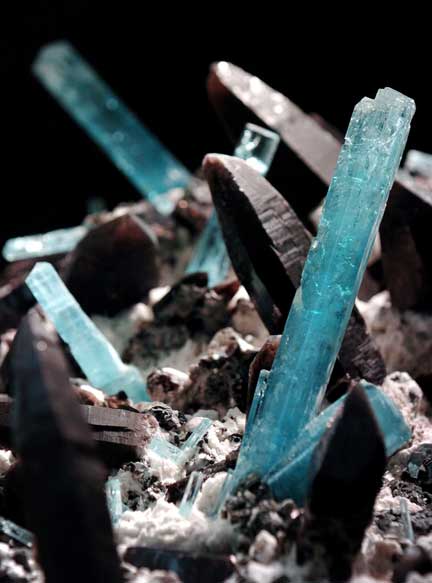 |
| Close-up showing the well defined crystals of black quartz and aquamarine. (Photo: Craig F. Walker, Denver Post) |
Brancato sold the specimen to Denver Museum of Nature & Science (DMNS) trustee Bruce Oreck for an undisclosed amount that was in the low six figures, according to the Rocky Mountain News. The piece was then donated to the museum where it now resides. The specimen was unveiled on November 10 and is now a permanent installation at the museum. DMNS president George Sparks called it a “stunning Colorado discovery,” and continued on to say, “Since the aquamarine is Colorado’s state gemstone, it is very special that we can display this awe-inspiring specimen.”
Yesterday’s print edition of The Denver Post included society columnist Joanne Davidson’s blog entry about the November 10 unveiling, at a museum fundraiser. [back to top]
— End December Newsletter • Published 12/2/06 —
October 2006 Newsletter
Shows, Conferences, and Exhibitions
- Mineralientage München, November 3–5, 2006
- IMA General Meeting, Kobe Japan – July 2006
A report by Dr. Marcus J. Origlieri - Gold! at AMNH, November 18, 2006 – August 19, 2007
Pala International News
Mineral News
- A Project in the RRUFF
- Moon Over the Pamirs
Richard Hughes et al. in Tajikistan - The Once and Future Sapphire
Vincent Pardieu in Madagascar
Books
Shows and Conferences
Mineralientage München
43rd Munich Mineral Show
November 3–5, 2006
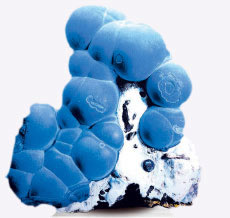 |
| Azurite specimen (Bisbee, AZ) from the special exhibit. |
Pala International’s Bill Larson will attend this major mineral show.
- When: Nov. 3–5, 2006
- Where: Munich Trade Fair Centre, Main Entrance West Halls B1, B2, B3
This year’s special exhibit is titled “Masterpieces: Rembrandts and Picassos of Nature.” It will include a 2000-ct. topaz and the biggest emerald crystal of North America, courtesy the Houston Museum of Natural Science.
For more information visit the show website. See the Pala International Show Schedule for future events. [back to top]
IMA General Meeting, Kobe Japan: A Report
The International Mineralogical Association (IMA) formed in 1958 to “further international co-operation in the mineralogical sciences and to promote wider community awareness among international groups having Earth Science interests.” The association currently has members from 38 different countries. The work of the IMA includes the operations of the Commission of New Minerals Nomenclature and Classification (CNMNC). The CNMNC sanctions the publication of new mineral names and decides on the appropriate nomenclature for minerals.
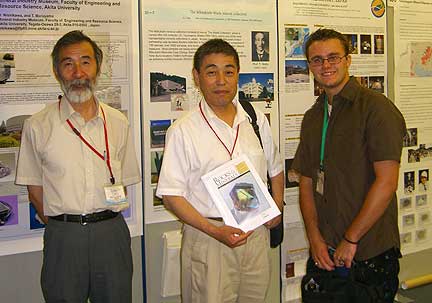 |
| Will Larson (right) distributes Pala International’s Minerals from Japan reprint to Japanese mineralogist attendees. |
The IMA holds a General Meeting every four years; this year the meeting took place in Kobe, Japan. The opening ceremony of the meeting, held in July, included a personal message from Prime Minister Junichiro Koizumi. In honor of the meeting, schools in the Kobe area had a special “mineral appreciation” day.
Publications of Note
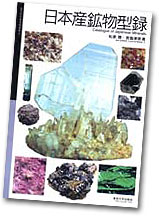 |
| A Catalogue of Japanese Minerals |
Two new publications on the mineralogy of Japan appeared during the conference. The first of these was published through the auspices of Pala International (see previous Mineral News). This publication, entitled Minerals from Japan, consists of a collection of reprints published in the Journal Rocks and Minerals. The articles discuss mineral collections, mineral shows, and field collecting in Japan, by John Rakovan (University of Miami, Ohio), Masao Kitamura and Osuma Tamada (Kyoto University), and Alfredo Petrov (Peekskill, New York).
The second publication, prepared by Satoshi Matsubara and Ritsuro Miyawaki, is titled A Catalogue of Japanese Minerals (Tokai University Press). Both these authors work as mineralogists at the National Science Museum in Tokyo. Matsubara began publishing catalogues of the mineral species of Japan in 1982. This book is the sixth edition, the first to be illustrated. Dr. Matsubara has issued numerous publications on topographic mineralogy of Japan, and for these contributions collaborators have named matsubaraite in his honor. The second author, Dr. Miyawaki, solves crystal structures of minerals, and has participated in the description of several new minerals from Japan.
Presentation Highlights
There were many contributions of interest to the mineral collector and gemologist. Frank Hawthorne (University of Manitoba, Winnipeg) presented a talk about amphibole nomenclature, wherein a group of IMA members is proposing a new nomenclature. This has an effect on the naming of certain gem materials, especially tremolite, actinolite, and pargasite.
 |
| Michiaki Bunno, Director of the Geological Museum (National Institute of Advanced Industrial Science and Technology), delivers his presentation, “Mineral Collections and Mineralogical Museums in Japan – A Review.” |
Professor Downs from the University of Arizona discussed the RRUFF Project (see our story below), which intends to obtain Raman spectral data for the entire mineral kingdom. The data collected for this endeavor is available to the public at www.rruff.info. These data enable the rapid identification of gems and minerals with a Raman spectrometer.
A session on gemstones began with a paper by Dr. James Shigley of the GIA on “HPHT-treated colorless and colored diamonds,” indicating that spectroscopy enables the distinction of treated from untreated stones. Emmanuel Fritsch discussed a specific mechanism of brown coloration in diamond. In an interesting talk on emeralds, Carlo Aurisicchio indicated that trace element chemistry allows determination of emerald origin. The session culminated in a talk by Ahmadjan Abduriyim on LA-ICP-MS analysis, which allows the detection and quantification of beryllium diffusion in corundum.
The full list of scientific sessions is available. The next General Meeting will be held in Budapest in 2010.
Gold! Natural Treasure, Cultural Obsession
American Museum of Natural History
November 18, 2006 – August 19, 2007
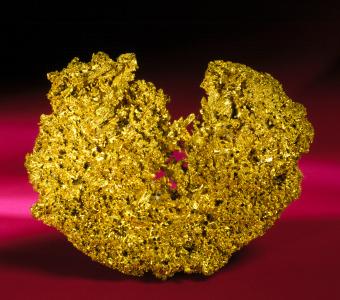 |
| Rare crystallized gold specimen, Colorado. (Photo: AMNH/ Denis Finnin) |
Next month, Manhattan’s American Museum of Natural History unveils Gold!—“an exhibition that will explore the historical fascination with this enduring icon of wealth, beauty, and power.”
The exhibition is another in a series that has featured amber, diamonds, and pearls.
On display will be some of the finest natural specimens culled from museums here and abroad, including the Natural History Museum–London’s 1.6-lb. Latrobe Nugget, the Golden Horn, and the Dragon, a delicate dragon-shaped specimen of matrix gold from California’s Colorado Quartz Mine.
The exhibition was organized in cooperation with The Houston Museum of Natural Science, where it was displayed last year. It claims to be “the largest and most comprehensive exhibition of gold objects, natural gold specimens, and gold bullion ever assembled.” [back to top]
Pala International News
Pala’s Featured Mineral Specimens: Malachite and Fluorite
In this edition of Mineral News we feature two small, exquisite cabinet specimens.
The first is a classic old Tsumeb pseudomorph of malachite replacing azurite. This is an exciting piece; as can be seen, the view angle is good from either side. The specimen was exchanged from the Gene Meirans collection. Mounted on a custom Sunnywood lucite base, it is a fine show-quality piece for the advanced collector. Price: $5500.00
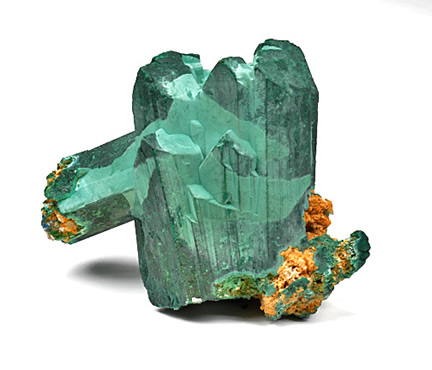 |
| Malachite after azurite from Tsumeb, Namibia, 7 x 5 cm. (Photos: Wimon Manorotkul) |
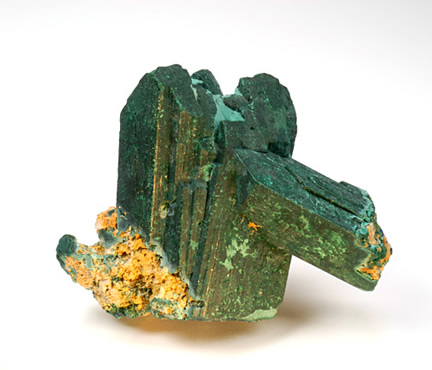 |
Our second featured piece is a vivid Moroccan fluorite on barite. This wonderful, bright, unusually colored specimen is very different from most Moroccan fluorites we have seen. Mined in 2004, it comes from the Taourirt Mine (near Taourirt, 108 km. south of Oujda, in the Oriental Region). It is very well priced at $400.00.
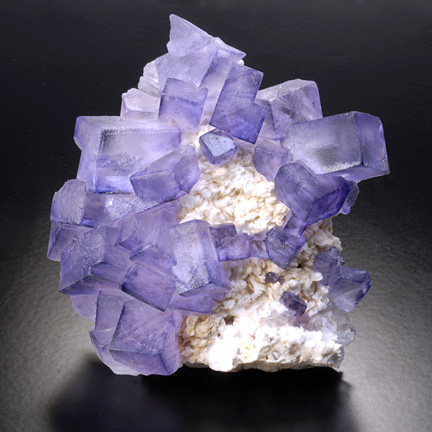 |
| Fluorite on barite from Taourirt, Morocco, 8 x 7.4 cm; the largest cube is 1.8 x 1.3 x 1.5 cm. This specimen has been sold. (Photo: Wimon Manorotkul) |
[back to top]
Larsons’ Presentations for China Conference
Pala International President Bill Larson and son Will Larson are preparing for their presentations this month to the 1st International Minerals & Gem Crystal Conference and Exhibition, China (as reported in our last issue).
In this edition, we give you a preview of their talks—extended abstracts that make for engaging reading.
Bill’s topic is “Tourmaline: Including the connection of San Diego Tourmaline Mines and China.” He tells a brief history of tourmaline and its characteristics, discusses the phenomenon of paraiba tourmaline and Pala International’s mining history, and finally, recounts the tale of how a Chinese monarch’s passion for colored stones kept Southern California miners busy.
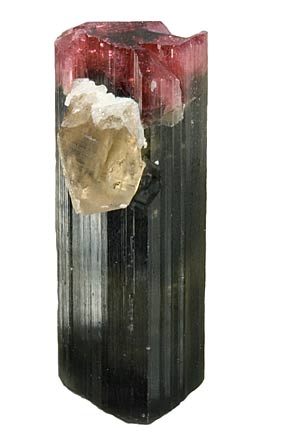 |
| Different. This double-terminated Himalaya Mine tourmaline contains a glassy red end that contrasts beautifully with the unique gray/green below it. (Photo: John McLean) |
Will Larson takes on a topic prized by any collector who began at an early age: “What collecting minerals means for the youth of China and America in the 21st century.” He discusses reasons young people collect, ideas behind what to collect, building a collection, and the prospects for collecting Chinese minerals at this time.
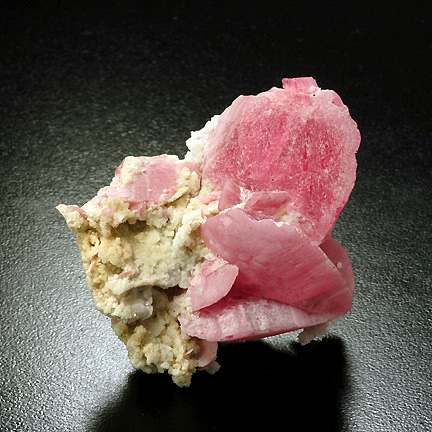 |
| Chinese rhodochrosite from the Sainte-Marie-aux-Mines show. One example of the new material from China that is offered at the gem shows frequented by Will Larson. (Photo: Wimon Manorotkul) |
[back to top]
Mineral News
A Project in the RRUFF
A group of researchers at the University of Arizona (UA) and Caltech, known as The RRUFF™ Project, has been quietly developing an online database for mineral identification. Their aim: “creating a complete set of high quality spectral data from well characterized minerals and... developing the technology to share this information with the world.”
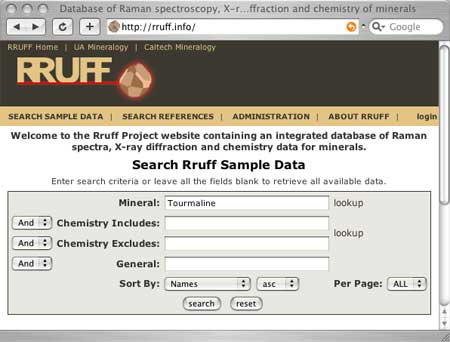 |
| Data search. Screenshot of the RRUFF™ data lookup form. |
Remember the Tricorder?
Star Trek fans are familiar with the “tricorder,” operated by waving over material to identify its chemical composition. Recent breakthroughs in miniaturization of spectroscopy instruments (known by the name of Raman after the Nobel prize winner, C.V. Raman) hold the promise of bringing such hand-held spectral identification to reality. Such a device is being developed by the UA team, but “[t]o use the vibrational spectrum as an identification tool, one must reference against a previously established database,” a project brochure explains. “The RUFF™ Project is developing such a database...”
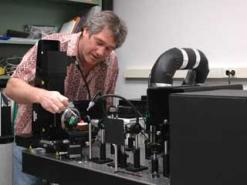 |
| Raman spectrometer. Dr. Downs conducts spectral analysis as part of the RRUFF™ Project. (Photo: Downs laboratory, UA) |
So for the first time, using instruments constructed from off-the-shelf components such as presentation pointer-type lasers, mineral and gem enthusiasts will able to compare their findings against reference ID entries—plural. As the RRUFF™ brochure points out, the database provides:
- easy retrieval of multiple data sets for a given sample
- expansibility to include data from alternative analysis and characterization
- linked documentation and references.
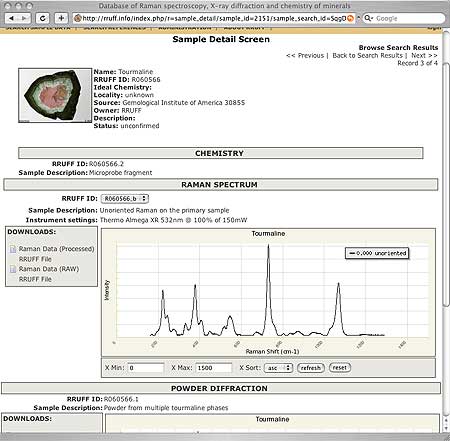 |
| Sample detail. Screenshot of one of four sample detail records returned on a search of “Tourmaline.” |
The database work is being performed by research groups of Drs. Robert T. Downs, M. Bonner Denton (UA Departments of Geosciences and Chemistry, respectively), and George Rossman (Caltech Geological and Planetary Science). The project is being sponsored by gemstone connoisseur Michael Scott.
IMA to House the Database
At the July meeting of the International Mineralogical Association (IMA) [Note: This links to a PDF], held in Kobe, Japan, it was decided that “IMA will move ahead with plans to become the home of the mineral database known as the RRUFF project.”
How to Help
Thumbnail samples of very rare minerals are still needed to complete the project library. Gem and mineral collectors, dealers, and enthusiasts are urged to contact The RRUFF™ Project. [back to top]
Moon Over the Pamirs: Richard Hughes et al. in Tajikistan
In July, Richard Hughes, Vincent Pardieu, Dana Schorr, and Guillaume Soubiraa ventured to Tajikistan to see for themselves the source of rubies appearing in Bangkok and being offered by email from Uzbekistan.
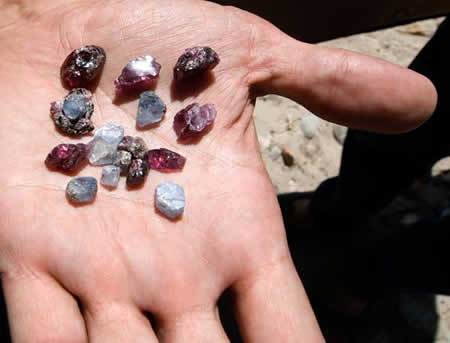 |
| A handful of sapphire and garnet crystals offered to Hughes and company in the Wakhan Corridor, including one on matrix. (Photo: © Richard W. Hughes/RWH Publishing) |
Their travels and bureaucratic travails take us from the relative European splendor of the capital Dushanbe, to Khorog (headquarters of the restricted spinel mining area), to the Kuh-i-Lal mines—some of the oldest in the world—on the Panj River at the Afghanistan border. What they’d heard, however, didn’t jibe with what they saw: no red spinel.
Then east on the Pamir highway, bedding down with (well not with) Kyrgyz hosts in what Hughes calls “Yurtisan” (after the portable dwellings—complete with East Coast-style radiators), and on to Murghab and the ruby mines of Snijnie on the Chinese border. They were not disappointed this time. While they were denied viewing or purchasing samples, they saw evidence of ruby in the marble matrix, and were told that the largest fine crystal was 200 grams.
 |
| A miner rests during lunch at Tajikistan’s ruby mines near the Chinese border. (Photo: © Richard W. Hughes/RWH Publishing) |
Then back to Dushanbe (via the Wakhan Corridor—and Kuh-i-Lal), and after much haggling with the mysterious “Gubjemast Company,” finally to view ruby samples.
Read the full story on ruby-sapphire.com and fieldgemology.com. [back to top]
The Once and Future Sapphire: Vincent Pardieu in Madagascar
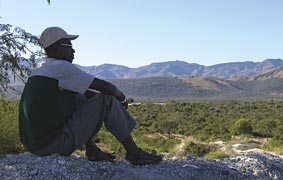 |
| Gaston, discoverer of sapphire, has much to ponder regarding the bright future of gemstone mining in Madagascar. (Photo: Vincent Pardieu) |
Readers of the Tajikistan tale above may be interested in Vincent Pardieu’s three-part report (penned with Richard W. Wise) on the mines of Madagascar: ruby, sapphire, and touching on tourmaline and emerald. Part 3 has just been posted on Colored Stone’s website.
In this final installment, Pardieu recounts the 1994 discovery of sapphire by Gaston, a young zebu keeper at the time, in Andranondambo. He continues by describing the synchronicity of increased production in Africa concurrent with Thai and Cambodian decline, leading to a present boomtown atmosphere in Madagascar. “I even had the impression, traveling from Ilakaka to Sakaraha and passing by Manombe, that there were more Sri Lankans than Thais.”
So similar are Ilakaka and Tunduru blue sapphires that buyers in Southeast Asia “are likely to buy ‘Ceylon sapphire’ which was in fact mined in either Madagascar or Tanzania.”
According to Pardieu, we ain’t seen nothin’ yet. He concludes the article with a bold estimation, which we can’t help but quote in full.
Geologically speaking, over 80 percent of the island could hold ruby and sapphire deposits. In less than 10 years, six ruby and sapphire deposits of different types have been discovered, but there is more to come. Madagascar has twice the gem-producing area of Myanmar and Sri Lanka added together: If the famous Mogok area in Myanmar or the Ratnapura area in Sri Lanka are a total of 50 km by 50 km (31 miles by 31 miles), Ilakaka is more than 300 km by 300 km (186 miles by 186 miles). And after only six years of production, Ilakaka is far from fully exploited. The potential in the jungle-covered areas of Vatomandry and Andilamena looks similarly enormous. There are new reports of alluvial rubies and sapphires being found in the deep, rain forest-covered mountains east of Andilamena up to Fenoarivo. Other potential mining areas exist east of the Fianarantsoa corundum deposits, and are also known in the south near Bekily, Ejeda, Betroka, and Ikongo; in the north near Andapa, Ambilobe, and even in the tourist paradise island of Nosy Be, where attractive purple sapphires have been found.
[back to top]
Books
The Smale Collection: Beauty in Natural Crystals
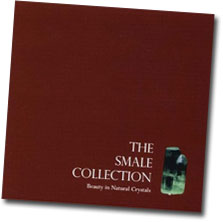 |
UC Berkeley mathematician Stephen Smale is known worldwide for, among other things, his theory of how to turn a sphere inside out. But Smale and his wife, Clara, also have an interest in the material world, as evidenced by the recently published book, The Smale Collection: Beauty in Natural Crystals.
Featuring 70 plates by photographer Jeff Scovil and 30 by Smale himself, the book includes specimens obtained from Pala International’s Bill Larson, such as the tourmaline pictured below.
As Smale explains on his website, “Our collection was started in 1969, partly with the realization that, while enjoying a moderate income, we could obtain some of the finest crystals, even competing with the best museums.” The photos on his website demonstrate that this is no idle boast. [back to top]
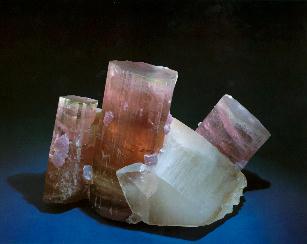 |
| Tourmaline crystals on quartz (3.75 in. across), Himalaya Mine, San Diego County, CA. (Photo: Steve Smale) |
— End October Newsletter • Published 10/2/06 —
Other August News
August 16: Ste-Marie Specimens Added
We’ve added several new specimens obtained at the Sainte-Marie-aux-Mines show.
August 7: Burma Crystal Market in Decline
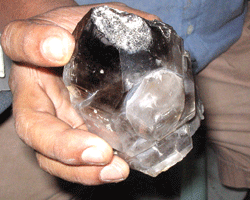 |
Dealers at Bogyoke Aung San Market claim that “[s]ales of crystals in Yangon have steadily decreased since the market boom of the early to mid 1990s,” according to a Myanmar Times article posted earlier this summer.
Crystal wholesaler Ko Myat Toe, of Crystal Hunter, cited a number of reasons: lack of supply, higher prices, and fewer buyers. Sales to foreign buyers, critical to the market, have fallen off, especially since the 9/11 attacks on the U.S.
August 2006 Newsletter
Welcome to this new edition of Mineral News From Pala International!
Sign up for the email version.
We’re pleased to offer you the first edition of our revamped Mineral News. This will be a bi-monthly newsletter, delivered the first week of even-numbered months. We’re open to suggestions and tips for stories, so don’t hesitate to send us feedback.
In this issue:
Show Schedule 2006
- Pala at Colorado Mineral & Fossil Show, Sept. 18–17
- GIA Symposium Features Pala Crystals, Presentation, Aug. 27–29
- Larsons to Present at China Mineral Show, Oct. 9–10
Pala International News
Mineral News
Show Schedule
Pala at Colorado Mineral & Fossil Show
September 13–17, 2006
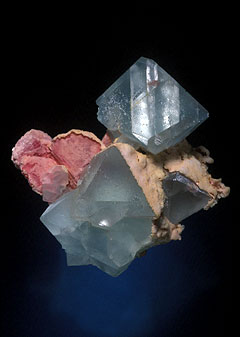 |
| Fluorite-rhodochrosite from Silverton, Colorado, 11.2 cm. (Photo: Jeffrey Scovil) |
Pala International will be at the Colorado Mineral & Fossil Show.
- When: Sept. 13–17, 2006
- Where: Holiday Inn Denver–Central, 4849 Bannock St.
- Room 183
- Hours:
Wed.–Sat.: 10 a.m.–6 p.m.
Sun.: 10 a.m.–5 p.m.
We look forward to seeing our many friends there. For more information visit the show website.
Visit the Pala International Show Schedule for future events.
East Coast Gem, Mineral & Fossil Show
This East Coast show is scheduled for August 11–13, 2006, in Springfield, MA. Get all the details here. [back to top]
GIA Symposium Features Pala Crystals, Presentation
August 27–29, 2006
Panel Presentation: “In the Jungle:
Locality of Origin – Does It Really Matter?”
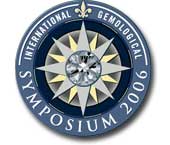 |
Pala International President Bill Larson will present at this year’s Gemological Institute of America Symposium, to be held August 27–29, 2006. Larson will share a panel with Lore Kiefert (AGTA lab director) and Christopher Smith (GIA NY lab research manager), moderated by Gary Roskin (Jewelers’ Circular Keystone Senior Editor).
- When: August 28, 2006
- Time: 4:00–5:30 p.m.
- Where: Manchester Grand Hyatt, One Market Place, San Diego
[back to top]
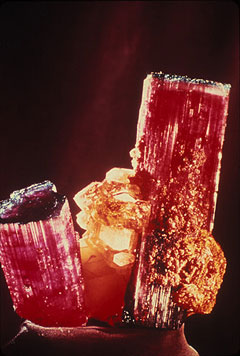 |
| This blue cap tourmaline will be on display. (Photo: Harold and Erica Van Pelt) |
Exhibition: “Celebrating Excellence in Gems and Jewelry”
In time for the Symposium, and extending through November, GIA will unveil a new display setup in the rotunda of the main building of its Carlsbad campus.
The inaugural exhibition, “Celebrating Excellence in Gems and Jewelry,” will include “super fine” local tourmaline and Burma ruby crystals from the collection of Pala’s Bill Larson as well as a centerpiece display by Symposium Premier Sponsor The Steinmetz Group, according to GIA sources.
The display system will use state-of-the-art fiber optic lighting, said the sources, and the exhibition’s “excellence” will merit the publication of a catalog, something rarely done by GIA.
Symposium attendees are urged to make time to view the show because, while it runs through November, a limited number of items will be on display only during the run of the symposium itself, GIA sources said. More information will be available, including an exhibition brochure, later in August. [back to top]
Larsons to Present at China Mineral Show
October 9–10, 2006
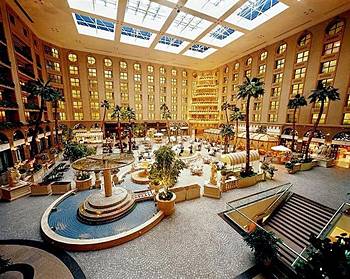 |
| Lobby of Beijing’s Tianlun Dynasty Hotel, site of the Chinese conference and show. |
Pala President Bill Larson and Bill’s son, Will Larson, are among the thirty international speakers slated to present at the 1st International Minerals & Gem Crystal Conference and Exhibition, China. Bill will speak on tourmaline, one of the great gems of world. He will discuss California production, including the California–China Connection. Will’s topic will discuss what collecting minerals means for the youth of China and America in the 21st century.
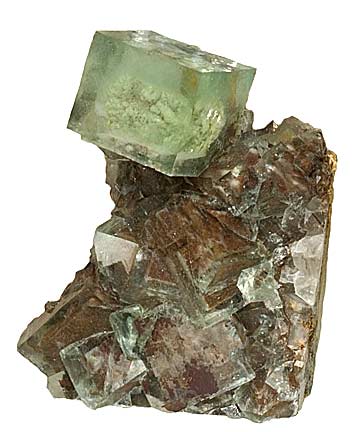 |
| A single clear fluorite crystal sitting on fluorite and matrix, from Hunan Province, China. (Photo: John McLean) |
 |
Mine Tours and New Book
The show’s sponsor, AAA Minerals International, offers purchasing-tours and locality/mine visits, and thus offers two optional mining area tours in Hunan Province before and after the October show.
- When: October 9–10, 2006
- Where: Tianlun Dynasty Hotel, Beijing, China
- Optional Tour: Oct. 2–8 or Oct. 11–17
AAA Minerals also has published a new book, Fine Minerals of China, by Guanghua Liu, which includes photos of Pala International specimens. [back to top]
Pala International News
Pala’s Featured Mineral Specimens: Kunzite and Aquamarine
For our “revival” issue of Mineral News, we’re excited to offer a single kunzite crystal along with a pair of aquamarines (priced separately).
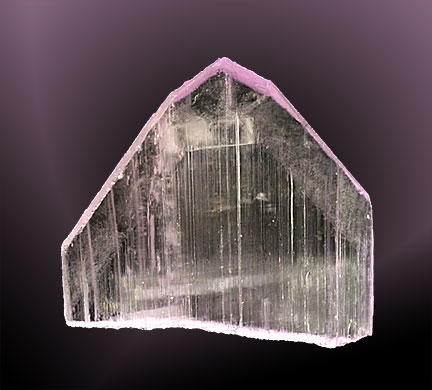 |
| Kunzite crystal from Paprock Afghanistan, 12.2 x 10.7 x 1.3 cm. Inventory #13795. (Photo: John McLean) |
This is a classic-form kunzite (above), from Paprock, Afghanistan. It is a complete, wonderful single crystal with no damage. Even the base is complexly terminated. The color is fine pink-purple down the “C” axis. Note the extra-sharp faces at the top of the crystal. An excellent cabinet specimen. Price: $2800.00.
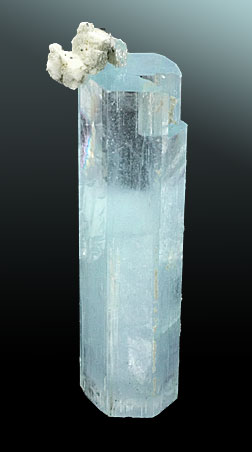 |
| Double-terminated aquamarine crystal with feldspar orthoclase, 8.6 x 2.4 x 2.2 cm. (Photo: John McLean) |
Above, an aquamarine from Shigar Valley, Pakistan. A beautiful and perfect specimen, with good color and proportions, doubly terminated. Brought to us in Sainte-Marie-aux-Mines directly from Pakistan by a good friend of Pala International. Price: $2400.00.
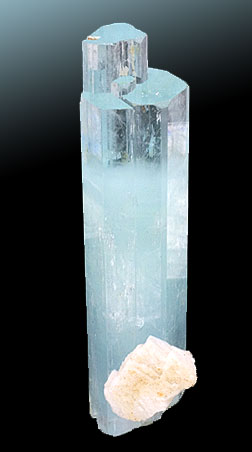 |
| Double-terminated aquamarine crystal with feldspar orthoclase, 9.9 x 2.3 x 2.1 cm. (Photo: John McLean) |
A second aquamarine from Shigar Valley, Pakistan. As with the above specimen, this is an exquisite, undamaged, doubly terminated specimen, delivered to us in Sainte-Marie from Pakistan by our friend. Bill Larson: “I love the termination complexity with the single rising above the base termination by a centimeter or so.” Price: $2400.00.
Pala’s Remodel
Last month we at Pala moved part of our operation back into the “back room,” a 488 square-foot renovation that made spacious use of unused storage space at the rear of the building. See the full story.
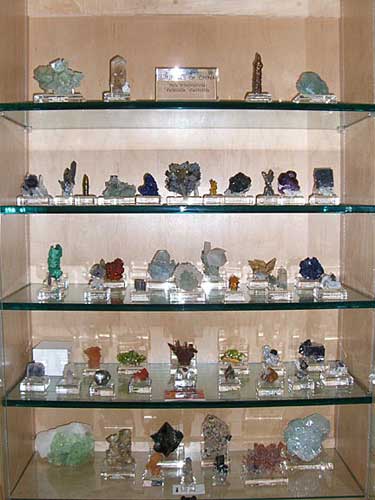 |
| Fifty-three-piece Chinese mineral collection displayed in Pala International’s remodeled office. |
[back to top]
Mineral News
Report from Sainte-Marie-aux-Mines 2006
This show remains one of my favorites, nestled in the charming village of Sainte-Marie-aux-Mines, in the Valley of Silver (val d’Argent), near Strasbourg, France, and in the middle of the Alsace wine region with charming restaurants featuring foie gras and other local specialties. Is there anything else missing? Oh yes: mineral specimens and gems. These are showcased by 650 international mineral dealers and 350 gem and jewelry dealers in booths filling two sections of the town’s streets and in several indoor halls.
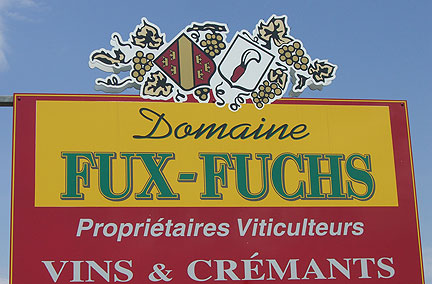 |
| What the...? This sign proclaims Fux-Fuchs to be a vintner of Crémant d’Alcace, a delicate sparkling wine, cousin to the region’s better known Gewürtztraminer and Riesling, and the leading sparkling wine on the French domestic market. |
I am traveling with my son, Will, and Mark Kaufman, a fine gem cutter and dealer from San Diego. The three of us were able to split up and cover a great deal of the show in a short period of time, catching whatever new was put out in the first days. Of course, to see finer things one must know the dealers, and then you’re shown things privately as in the USA.
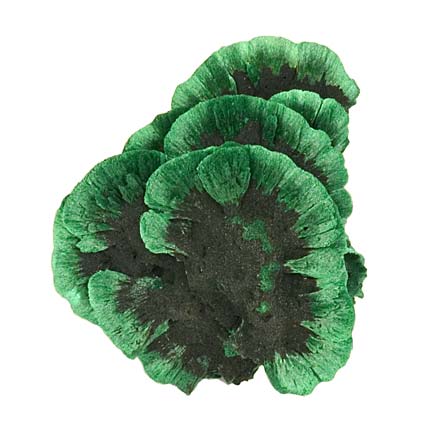 |
| Green velvet. This malachite (6.1 x 5.1 x 5.1 cm), acquired at the Ste-Marie show, is from Katanga, Congo. It has an incredible velvet shine on the edges. Very showy. Price: $650.00. See more specimens from the show for sale. (Photograph: John McLean) |
This year the new minerals were rhodochrosites from China. We saw these with several Chinese dealers. No one seemed to have an exceptional specimen, but many examples were very nice miniatures. These were in the 200 euros cost range. (See what we brought back. We’ll be adding new items for the next few days.)
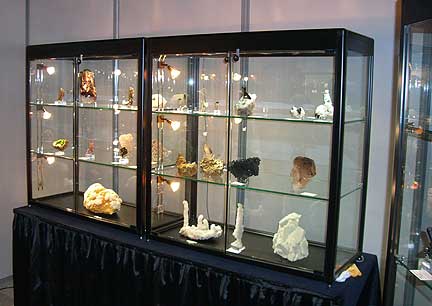 |
| No cheap theatrics here. A typical mineral display in the theatre at Sainte-Marie-aux-Mines. |
A rubellite pocket found two years ago in Luc Yen, Vietnam, was on display and priced for the first time. These tourmaline specimens were also featured in the current issue of Lapis magazine (see below), with the best matrix piece featured on the cover. This piece was excellent; it was repaired, as most larger tourmaline matrixes are, and sold on the first day.
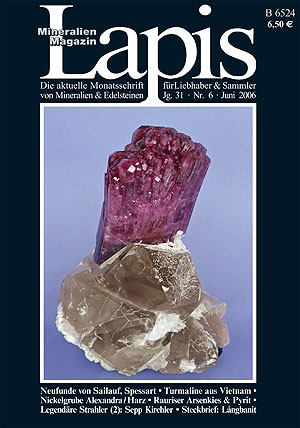 |
| A bold debut. Exhibited at the Sainte-Marie-aux-Mines show was the tourmaline matrix specimen pictured on the cover of the June 2006 Lapis magazine. |
Among the fine things we saw were many new, small, but beautiful aquamarines from Shigar Valley (Pakistan). And a few select kunzites from Paprock, Afghanistan, as well as many nice tourmalines from Afghanistan. Mark found a great selection of purple scapolites from Tajikistan that were excellent single crystals, but will probably be sacrificed to the cutting wheel due to the increased sums gem collectors will pay.
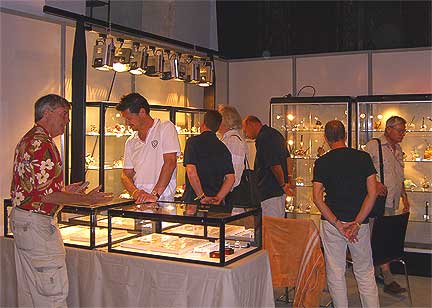 |
| Talking turkey. Pala’s Bill Larson (left) discusses the quality of last evening’s foie gras with known connoisseur Marcus Budil—and today’s mineral purchases. |
Inside the theatre—many downtown buildings, including this one are used for the show—are clustered the top-quality mineral dealers, mostly from European countries. This year the theatre’s stage had been selected for dealers with finer pieces, and so the tone inside the theatre was raised a notch. Next year it is rumored that the genius who conceived and owns the show, Michel Schwab, is going to upgrade the theatre even more to highlight the finest minerals available. He also had a few displays of interesting exhibits, including fine French fluorite specimens; I hope he will expand this excellent idea.
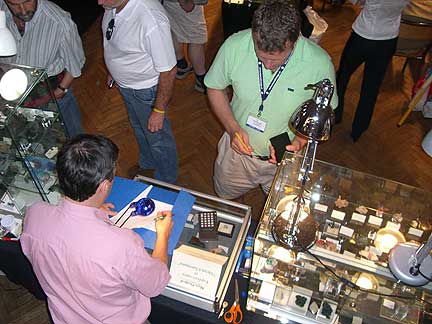 |
| Class act. Looking down on Alain Martaud’s booth from the stage in the local theatre that serves as a marketplace for top-quality minerals, most from European countries. |
The show was great, but not easy to find many things for a dealer, as prices were high due to the strong euro and generally higher prices than in producing countries.
Sainte-Marie 2007 is June 21–22 for dealers and June 23–24 for the public. To learn more, visit the show website. [back to top]
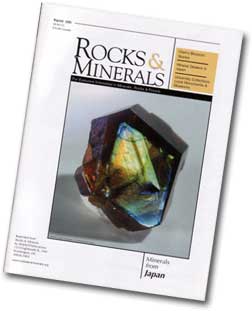 |
Minerals from Japan
Minerals from Japan, available from Rocks & Minerals is a 40-page illustrated reprint of recent articles by John Ravokan (Dept. of Geology, Miami University, Oxford, OH).
The reprint can be ordered from Rocks & Minerals, 5341 Thrasher Dr., Cincinnati, OH 45247, USA. The cost is $8 postpaid to US addresses, $14 outside the US. There is no online order form.
This important reprint collects five articles, published within the last twelve months:
- News from Japan, a four-part series by John Rakovan, with Alfredo Petrov
- Part 1: Kyoto Mineral Shops, the Masutomi Geology Museum, and Cherry Blossom Stones
- Part 2: The Wada Mineral Collection, Ikuno Mine, Rainbow Garnet, and Mineral Dealers in Japan
- Part 3: Ko Mineral Collection, Osaka and Tokyo Shows, and Collecting Sakura Ishi and Rainbow Garnets
- Part 4: The University of Tokyo (Wakabayashi) and National Science Museum (Sakurai) Collections, and a Plethora of Local Monuments and Mineral and Mining Museums
- Sakura Ishi (Cherry Blossom Stones), by John Rakovan, Masao Kitamura (Department of Geology & Mineralogy, Kyoto University), and Osamu Tamada (Graduate School of Human and Environmental Sciences, Kyoto University)
Pala International recommends this publication to any mineral enthusiast who loves locality collections or who want to learn about the state of the hobby in Japan. And don’t miss this report by Will H. Larson of the 2005 Tokyo Mineral Show. [back to top]
New Book: Fine Minerals of China
 |
A new book, Fine Minerals of China: A Guide to Mineral Localities, by Guanghua Liu, has just been released. Fully illustrated, with 600 photographs and 55 maps, it includes photos of several specimens from the collection of Pala’s Bill Larson, as shown below. Some of these specimens are included in a beautiful fifty-piece Chinese Collection (on handsome Sunnywood mounts) displayed at The Collector Fine Jewelry.
The book is published by AAA Minerals, owned by the author. The company is the sponsor of the China mineral show in the news item above.
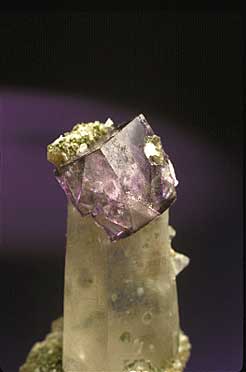 |
| Page 222. Purple fluorite crystal (1.7 cm) on top of quartz crystal from Yaogangxian tungsten mine. (Pala International China collection; on display at The Collector Fine Jewelry) |
The book’s material covers 60 localities in 13 provinces, 45 location descriptions, and data on 399 meteorites, 116 types of minerals, and 420 potential deposits. It is available from the publisher.
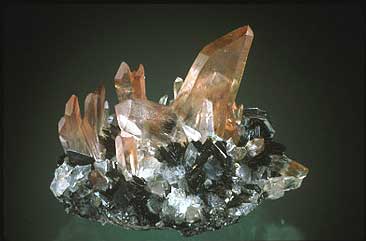 |
| Page 58. Japan-law twinned red quartz on hematite rosettes from Jinlong iron mine, 9 cm wide. (Bill Larson collection) |
Jeffrey Scovil, who photographed the Pala specimens shown here, wrote this account of his travels with Dr. Liu in Hunan Province in 2004, published in Rocks & Minerals.
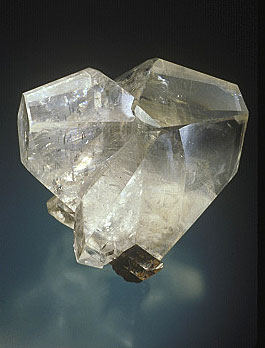 |
| Page 83. Clear twin calcite from Daching mine, 13 cm wide. (Bill Larson collection) |
About the Author
Guanghua Liu, PhD is a coal geologist and mineral dealer originally from China, now residing in Tübingen, Germany. He owns the consulting and trading company, AAA Minerals International.
Dr. Liu has an academic career spanning nearly 30 years, graduating from Jiaozo Mining College, then receiving his Masters Degree in Coal Geology and Sedimentology from China University of Geosciences, at which he became associate professor, finally receiving his doctorate in Geology from Tübingen University, where he joined the geological department’s scientific staff. Widely published, Dr. Liu is guest professor at China University of Mining and Technology and China University of Geosciences in Beijing.
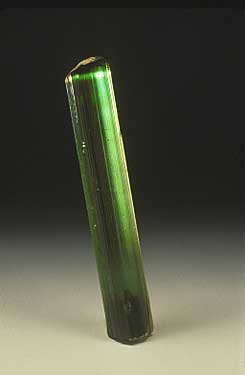 |
| Page 312. Tourmaline crystal, gem quality, from Gaoligongshan area, Yunnan Province, 18.1 cm tall. (Bill Larson collection) |
Dr. Liu was co-recipient, with Berthold Ottens, of the Friends of Mineralogy 2006 Award for Best Article 2005, for a collection of articles on Chinese mineral localities (The Mineralogical Record, 36:1, pp. 4–80).
Thomas P. Moore, in his review of Dr. Liu’s contribution to ExtraLapis: Calcite (2003) remarked on the benefit of a reference on Chinese localities:
As a preliminary reference work on these localities, this chapter is invaluable: I suspect it is typical that, of the three Chinese calcites in my own collection, two of them came with locality attributions totally unlike the ones given here for what’s obviously the material shown in the photos.
[back to top]
— End August Newsletter • Published 8/2/06 —
